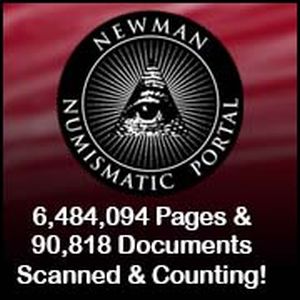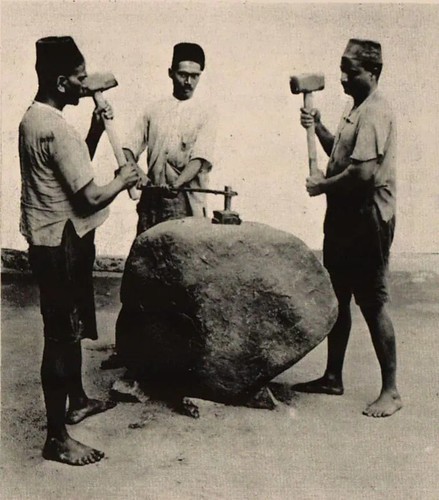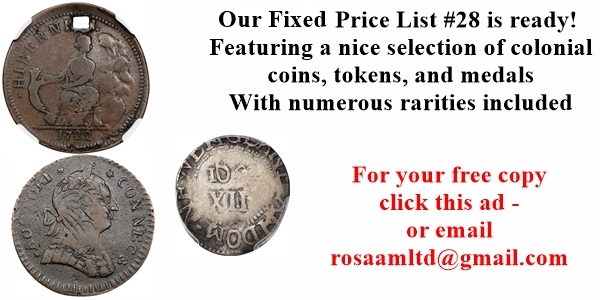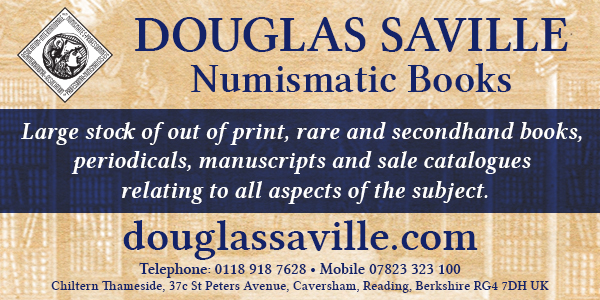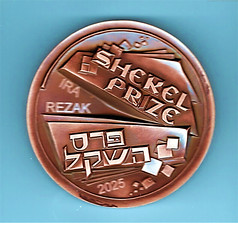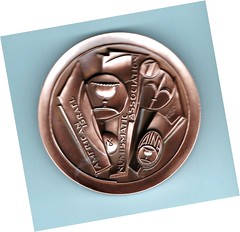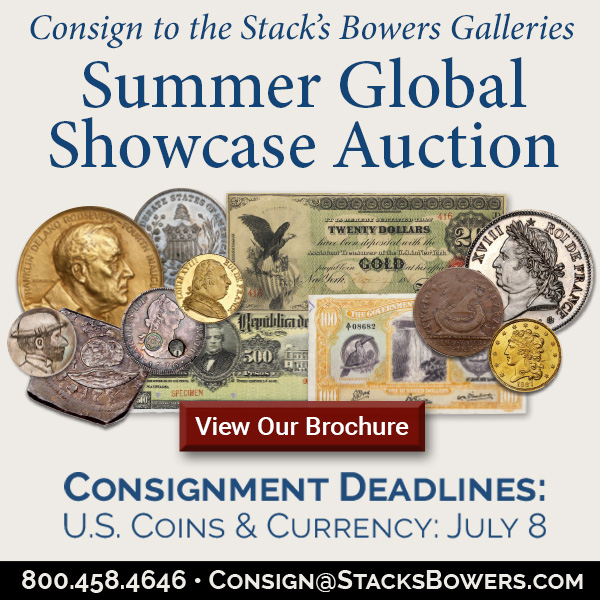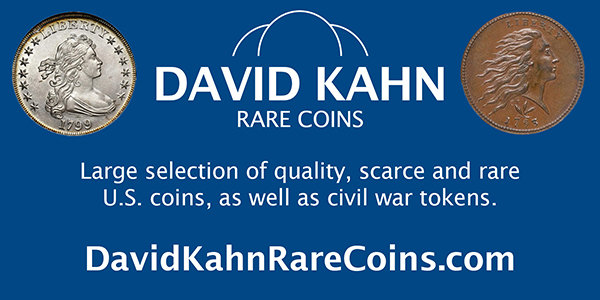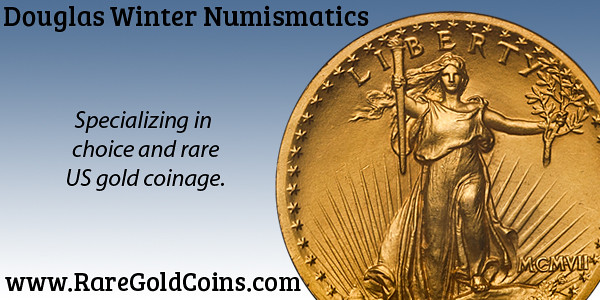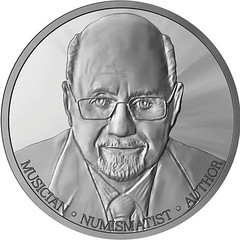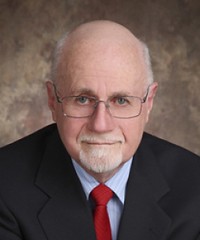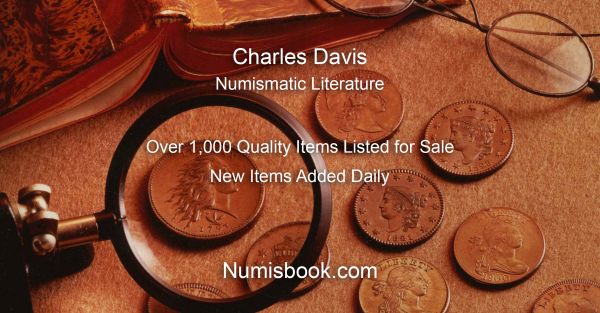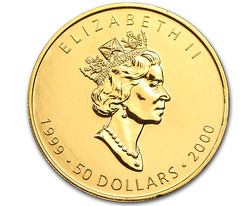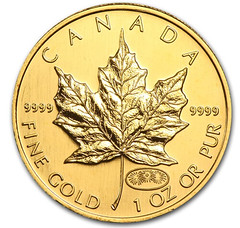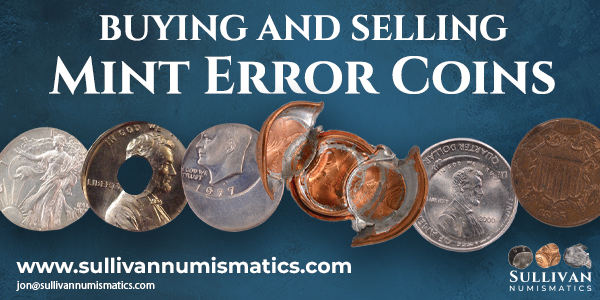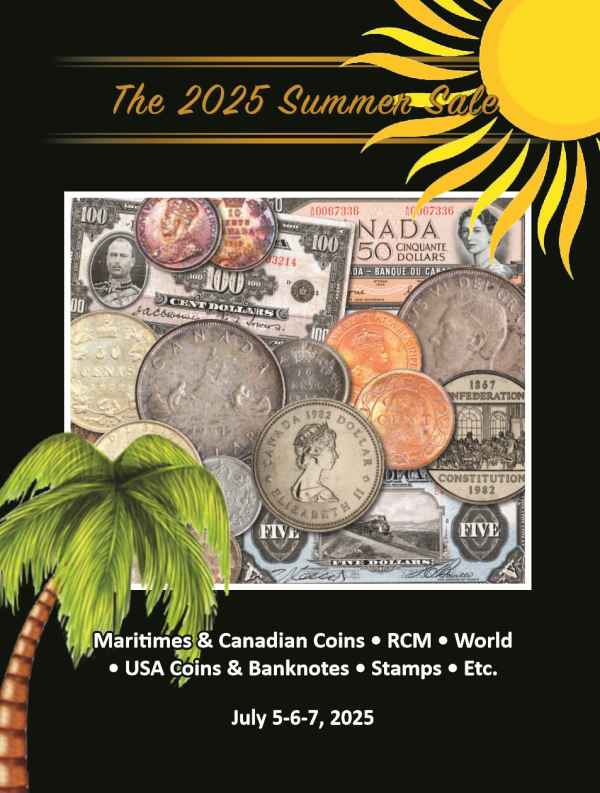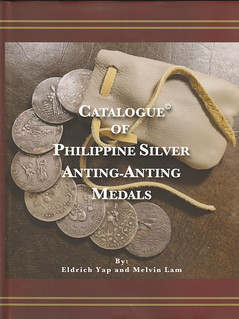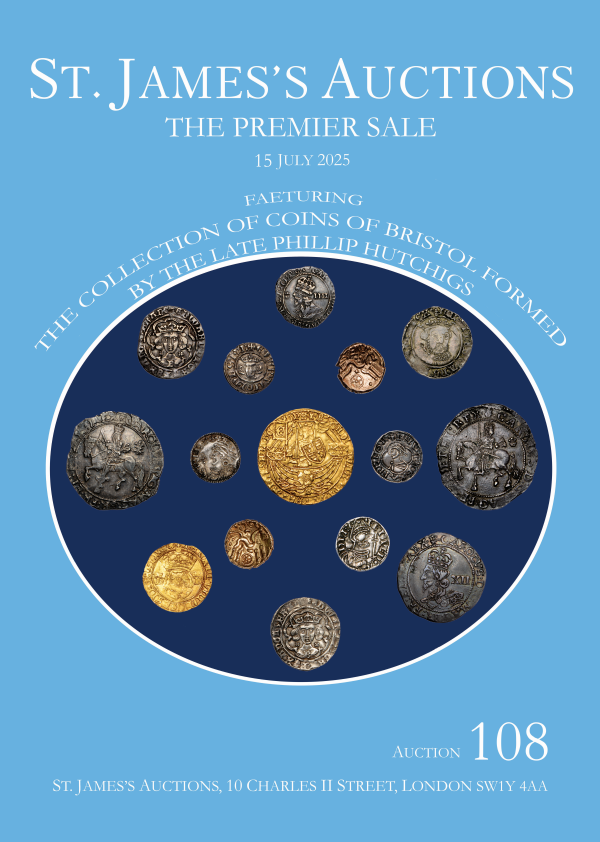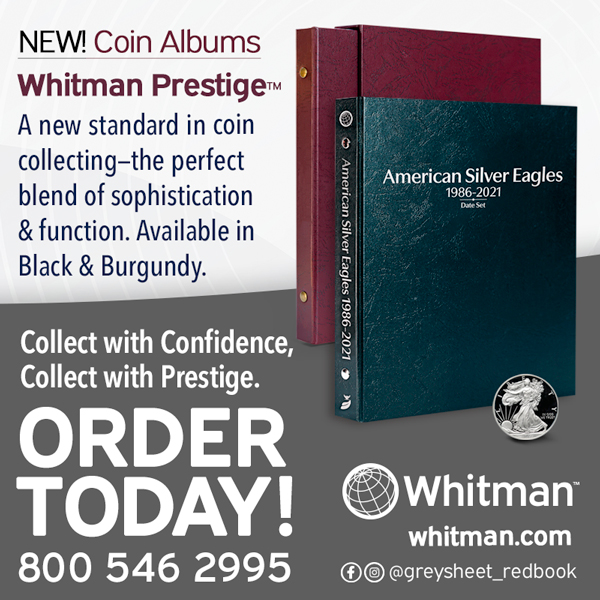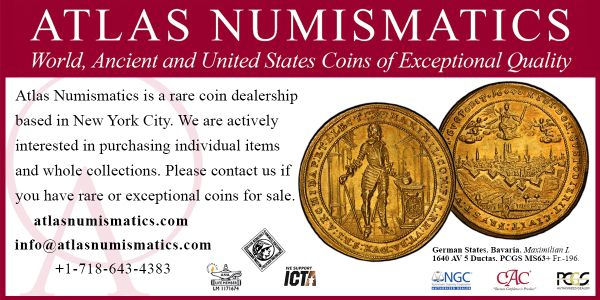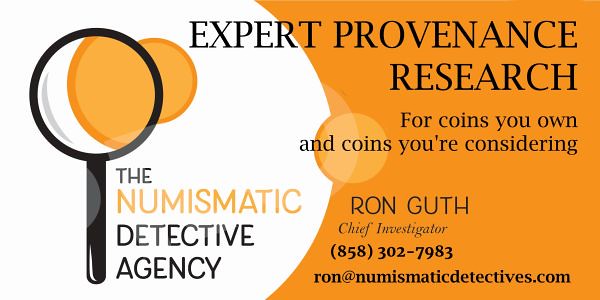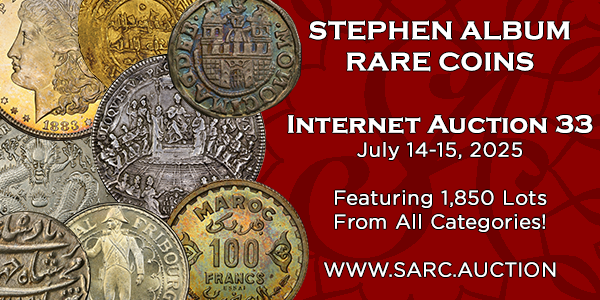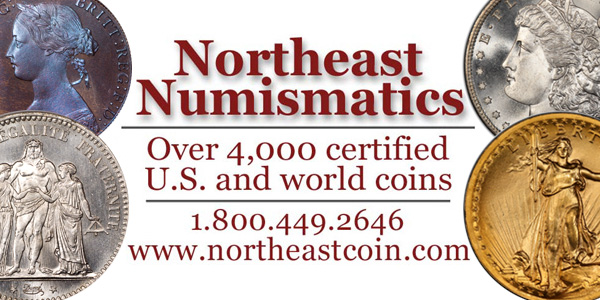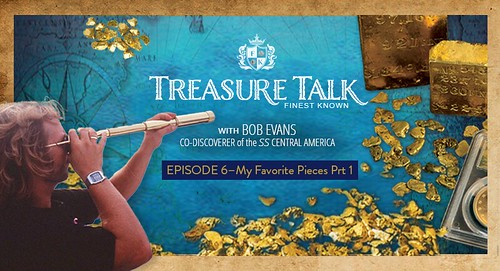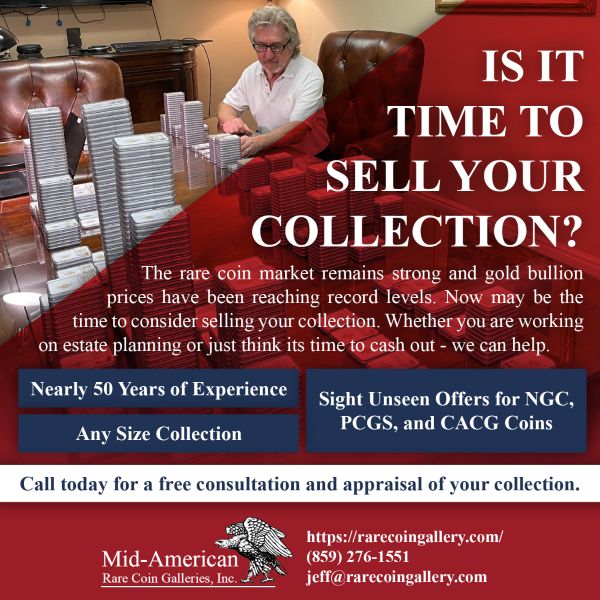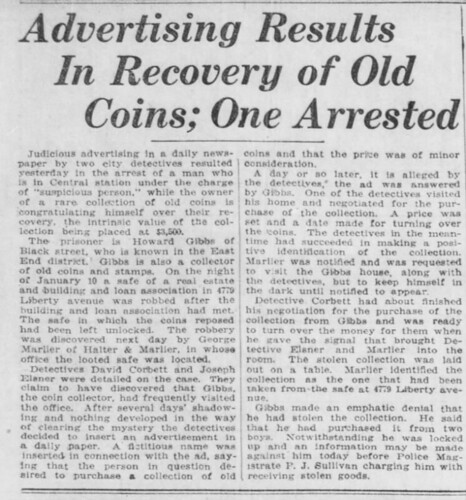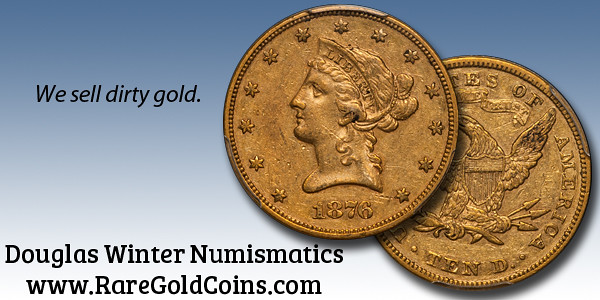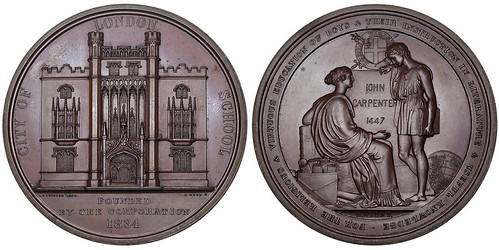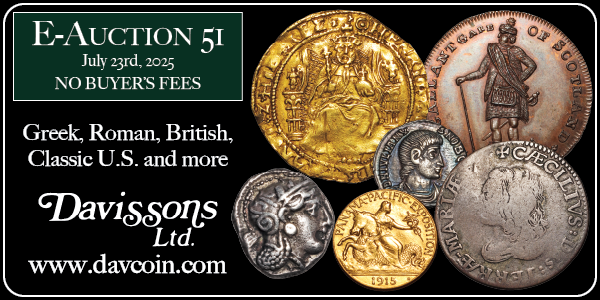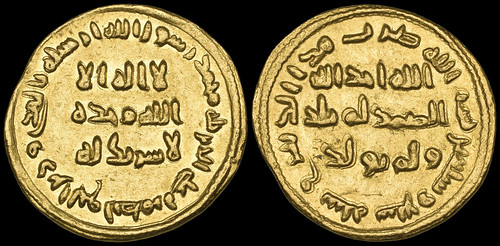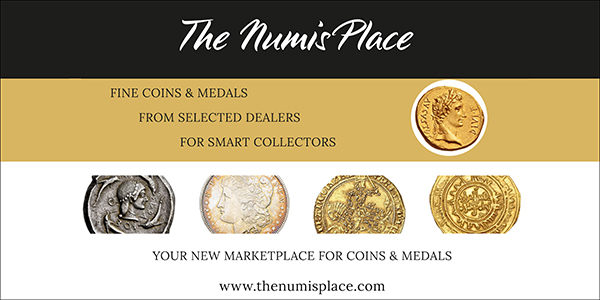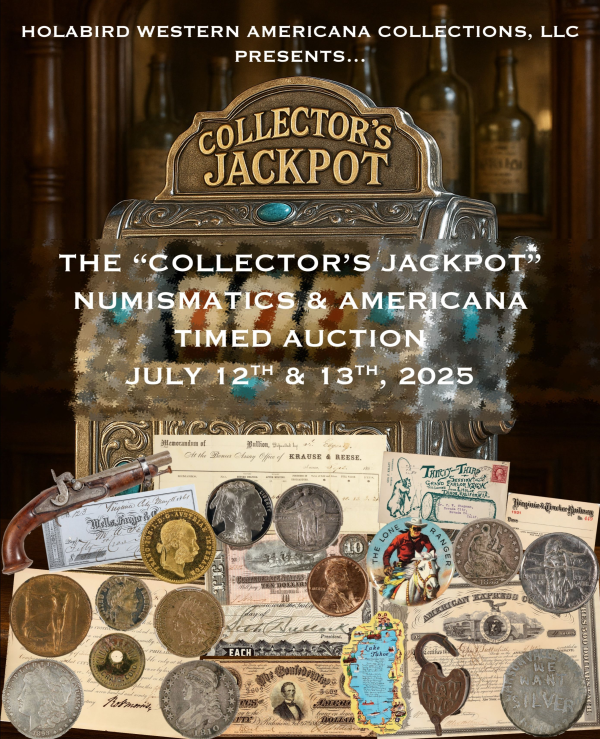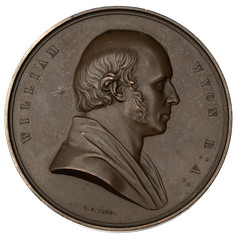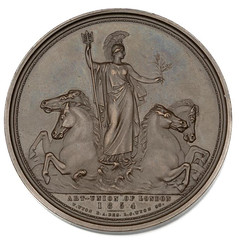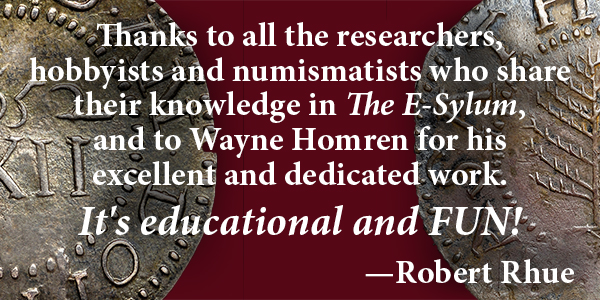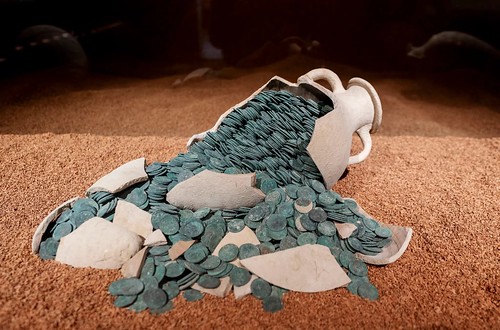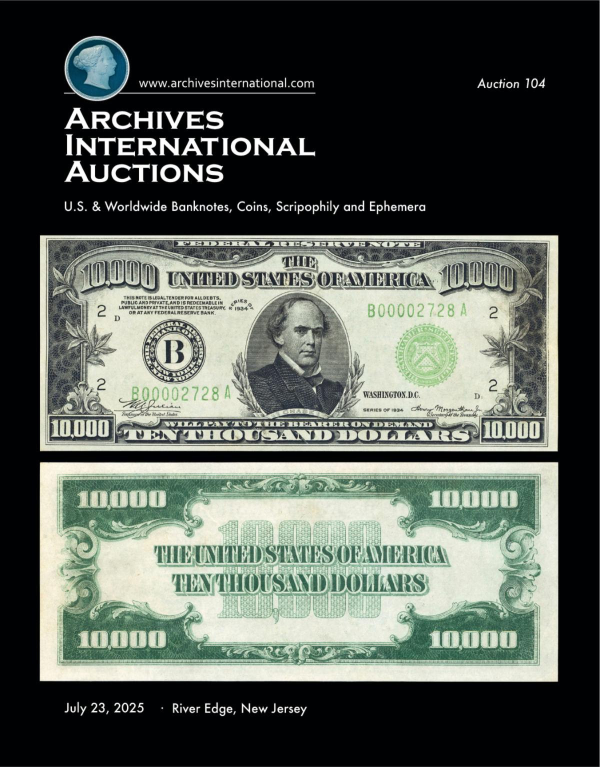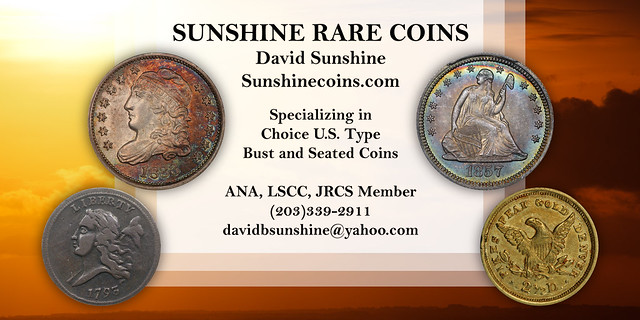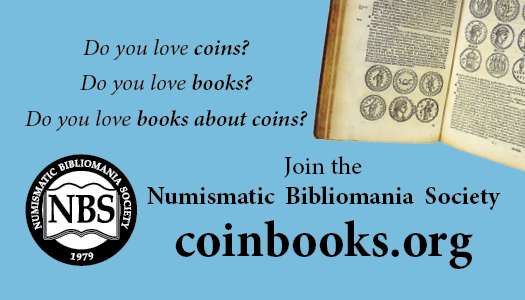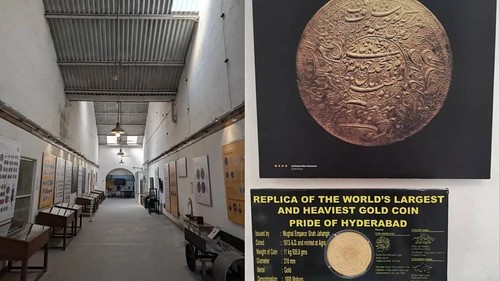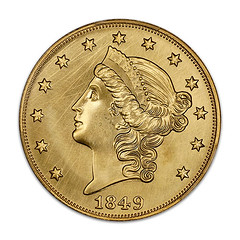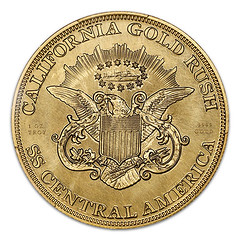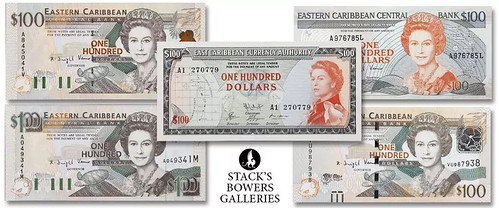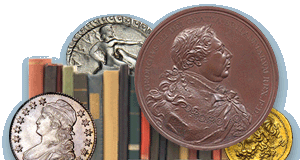
Visit our NBS Sponsors


About UsThe Numismatic Bibliomania Society is a non-profit association devoted to the study and enjoyment of numismatic literature. For more information please see our web site at coinbooks.org SubscriptionsThose wishing to become new E-Sylum subscribers (or wishing to Unsubscribe) can go to the following web page link MembershipThere is a membership application available on the web site Membership Application To join, print the application and return it with your check to the address printed on the application. Print/Digital membership is $40 to addresses in the U.S., and $60 elsewhere. A digital-only membership is available for $25. For those without web access, write to: Jeff Dickerson, Treasurer AsylumFor Asylum mailing address changes and other membership questions, contact Jeff at this email address: treasurer@coinbooks.org SubmissionsTo submit items for publication in The E-Sylum, write to the Editor at this address: whomren@gmail.com BUY THE BOOK BEFORE THE COINSale Calendar
|
- WAYNE'S WORDS: THE E-SYLUM JULY 6, 2025
- NEW BOOK: NUMISMATIC HISTORY OF BARIKOT
- NEW BOOK: SIAM SPECIMEN BANKNOTES THIRD SERIES
- 2025 SHEKEL PRIZE ANNOUNCED
- NEW BOOK: JEWRY REFLECTED, REFRACTED AND RECORDED
- HAPPY BIRTHDAY, GENE HESSLER
- AN AMERICAN MEDAL DEPICTING FIREWORKS?
- VIDEO: SOUTHERN CALIFORNIA NATIONAL BANK NOTES
- NOTES FROM E-SYLUM READERS: JULY 6, 2025
- ANA CONTRIBUTORS RECOGNIZED AT 2025 WFOM
- VOCABULARY TERM: CAMEOGRAPH
- SAMUEL BRECK (1771-1862)
- THE FRIEDBERGS' DEPARTMENT STORE COIN SHOPS
- TREASURE TALK WITH BOB EVANS, EPISODE 6.1
- HOWARD GIBBS COIN ROBBERY ARREST
- NUMISMAGRAM MEDAL SELECTIONS: JULY 6, 2025
- ST. JAMES'S AUCTIONS JULY 2025 SALE
- COMPLETE SET OF UMAYYAD GOLD DINARS
- DAVISSONS E-AUCTION 51
- NUMISMATIC NUGGETS: JULY 6, 2025
- SPANISH MUSEUM DISPLAYS 50,000 COIN HOARD
- EXPLORING THE COINS OF CHARLEMAGNE
- 2026 SEMIQUINCENTENNIAL COINAGE
- HYDERABAD HOTEL TOKENS
- THE SAIFABAD MINT MUSEUM
- 1849 $20 CENTRAL AMERICA COMMEMORATIVE
- EAST CARIBBEAN STATES CURRENCY
- LOOSE CHANGE: JULY 6, 2025
- FEATURED WEBSITE: HISTORICAL MEDAL SOCIETY
- ABOUT THIS ISSUE: JULY 6, 2025
Content presented in The E-Sylum is not necessarily researched or independently fact-checked, and views expressed do not necessarily represent those of the Numismatic Bibliomania Society.
WAYNE'S WORDS: THE E-SYLUM JULY 6, 2025
 New subscribers this week include:
Ethan Koerner,
Welcome aboard! We now have 7,247 subscribers.
New subscribers this week include:
Ethan Koerner,
Welcome aboard! We now have 7,247 subscribers.
Thank you for reading The E-Sylum. If you enjoy it, please send me the email addresses of friends you think may enjoy it as well and I'll send them a subscription. Contact me at whomren@gmail.com anytime regarding your subscription, or questions, comments or suggestions about our content.
Happy birthday to author and researcher Gene Hessler, who turned 97 today!
This week we open with three new books, the Shekel Prize, updates from the Newman Numismatic Portal, notes from readers, and more.
Other topics this week include cameographs, Samuel Breck, Howard Gibbs, Robert Friedberg, department store coin shops, fixed price and auction offerings, gold dinars, the coins of Charlemagne, Hyderabad hotel tokens, East Caribbean States currency, and the Historical Medal Society.
To learn more about the finds from Barikot, Siam Specimen Banknotes, the 250th Anniversary of Jewish Settlement in America, Founding Father John Adams, Southern California National Bank Notes, the 2025 American Liberty High Relief Gold Coin, varieties of 1857-S double eagles, the Cathedral of St. Maria, Gothic crowns and florins, the Lord Baltimore shilling, the Saifabad Mint Museum, the Calexico National Bank of California, and Philippine Anting Anting medals, read on. Have a great week, everyone!
Wayne Homren
Editor, The E-Sylum
NEW BOOK: NUMISMATIC HISTORY OF BARIKOT
The July 2025 emailing from the American Numismatic Society announced their library's acquisition of a new book on the numismatic history of Barikot. -Editor
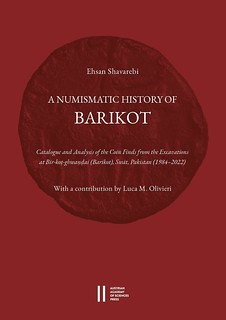 A numismatic history of Barikot : catalogue and analysis of the coin finds from the excavations at Bir-kot-ghwandai (Barikot),
A numismatic history of Barikot : catalogue and analysis of the coin finds from the excavations at Bir-kot-ghwandai (Barikot),
Swat, Pakistan (1984-2022) Ehsan Shavarebi ; with a contribution by Luca M. Olivieri ; edited by Michael Alram and Abdul Samad.
Publisher:Vienna, Austria : Austrian Academy of Sciences Press, [2025]
Description:469 pages : color illustrations, charts, maps, plans ; 30 cm.
ISBN:9783700195511.
Here's the book description from Amazon. -Editor
The present volume explores the coins unearthed during the excavations at the ancient city of Barikot (Swat Valley, northern Pakistan) between 1984 and 2022. The excavations of the Italian Archaeological Mission at Barikot have revealed numerous settlement phases from the prehistoric to the Islamic times. Of particular significance are over 500 coin finds, which are placed in their historical context in this volume to draw a clear picture of the monetary circulation in the Swat Valley (Uddiyana) throughout antiquity and the early Islamic period.
NEW BOOK: SIAM SPECIMEN BANKNOTES THIRD SERIES
Jan Olav Aaamlid's new book Siam Specimen Banknotes Third Series is available for preorder. Here's information from the publisher's site. -Garrett
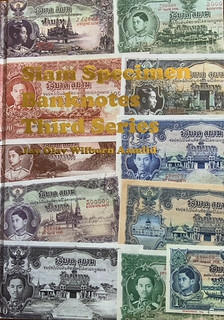 Siam Specimen Banknotes Third Series
Siam Specimen Banknotes Third Series
By: Jan Olav Aaamlid
The history of Thailand during this time is very interesting. There was a coup in 1932 and the King, Prajadhipok, Rama VII, abdicated in England in 1935. Thailand got a new King, at the time living in Switzerland - King Ananda, Rama VIII. During this short period (only about six years) Thailand had four different Ministers of Finance, and their titles changed several times - this all reflects on the banknotes, which also had to be changed accordingly.
After Rama VII abdicated, the printer Thomas de la Rue & Company Ltd in London was instructed to ante-date the banknotes prior to his abdication. At that time it was a lengthy process to make a new banknote, so the Ministry of Finance decided only to change the portrait of the King, which would take 6 to 8 weeks. After the portrait was engraved, an additional 6 weeks would be required to incorporate the engraving into the banknote die and manufacture the new printing dies.
2025 SHEKEL PRIZE ANNOUNCED
The Shekel Prize is awarded annually to the best book published on the topic of ancient Judaean coins, coins of the Holy Land or Judaic numismatics. Here's the announcement of the 2025 winner. -Editor
Ira Rezak's prize-winning book Jewry Reflected, Refracted and Recorded on Medals
is based on an exhibition of his material at New York's Center for Jewish History.
The phrase "Jewry reflected, refracted, and recorded in medals" is a compelling description of the way Jewish history, culture, and experience are represented and preserved through the art and craft of medals
NEW BOOK: JEWRY REFLECTED, REFRACTED AND RECORDED
We haven't covered this book before, so here's more information. The catalog was a limited edition and was only sold at the Center for Jewish History. I was unable to find it online, so it may be sold out. However, it's also readily accessible on-line at the academia.edu website. Here's an excerpt and some sample pages. -Editor
curated by Ira Rezak
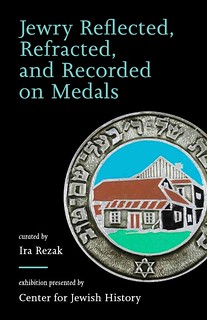 The curatorial question, for the collector as well as for the museologist, is
how to distinguish, characterize, and organize Jewish medals and their kindred
forms. Earlier definitions and categorizations tended to be strict, requiring
selected items to have been made by Jews or to feature explicitly Jewish content.
Even when adopting such seemingly precise criteria, however, there remain
challenging questions of how actually to define the terms Jew and Jewish and
thus how ultimately to limit what fits and what to select within these categories.
Such questions have been much debated subjects about which reasonable
persons will differ; the present introductory essay is not the place to resolve such
questions. Suffice it here to say that the modern museological tendency, and the
choices made by this observer for this exhibition, favor a generous approach,
inclusive of items that may not meet the strictest of definitions, but which
offer evidence for contextualizing and thus understanding Jewish history in
the broadest sense. As an example, with respect to text, the presence of Hebrew
might have seemed to prove Jewish origin irrespective of the author, while
with respect to imagery the mere presence of Jesus might be seen automatically
to disqualify a specimen. However, Hebrew in Christian context surely shows
significant Jewish influence, if not immediate presence, and the use of Hebrew
texts in connection with Christian images once again provides evidence of the
historical linkage between the two biblical religions.
The curatorial question, for the collector as well as for the museologist, is
how to distinguish, characterize, and organize Jewish medals and their kindred
forms. Earlier definitions and categorizations tended to be strict, requiring
selected items to have been made by Jews or to feature explicitly Jewish content.
Even when adopting such seemingly precise criteria, however, there remain
challenging questions of how actually to define the terms Jew and Jewish and
thus how ultimately to limit what fits and what to select within these categories.
Such questions have been much debated subjects about which reasonable
persons will differ; the present introductory essay is not the place to resolve such
questions. Suffice it here to say that the modern museological tendency, and the
choices made by this observer for this exhibition, favor a generous approach,
inclusive of items that may not meet the strictest of definitions, but which
offer evidence for contextualizing and thus understanding Jewish history in
the broadest sense. As an example, with respect to text, the presence of Hebrew
might have seemed to prove Jewish origin irrespective of the author, while
with respect to imagery the mere presence of Jesus might be seen automatically
to disqualify a specimen. However, Hebrew in Christian context surely shows
significant Jewish influence, if not immediate presence, and the use of Hebrew
texts in connection with Christian images once again provides evidence of the
historical linkage between the two biblical religions.
HAPPY BIRTHDAY, GENE HESSLER
Happy 97th birthday to numismatic researcher, author and curator Gene Hessler! See Pete Smith's earlier article for Gene's bio. Here's a gallery of photos to celebrate the day. -Editor
AN AMERICAN MEDAL DEPICTING FIREWORKS?
On this Fourth of July weekend in the U.S., Newman Numismatic Portal Project Coordinator Len Augsburger has a question for readers. -Editor
Is There An American Medal Depicting Fireworks?
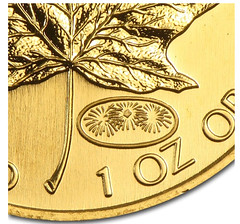 The tradition of displaying fireworks on Independence Day, July 4th, is a long-standing one, dating back to the very first organized celebrations of the holiday in 1777. Founding Father John Adams foresaw such commemorations from the very beginning, writing to his wife Abigail on July 3, 1776
The tradition of displaying fireworks on Independence Day, July 4th, is a long-standing one, dating back to the very first organized celebrations of the holiday in 1777. Founding Father John Adams foresaw such commemorations from the very beginning, writing to his wife Abigail on July 3, 1776 I am apt to believe that it will be celebrated, by succeeding Generations, as the great anniversary Festival. It ought to be commemorated, as the Day of Deliverance by solemn Acts of Devotion to God Almighty. It ought to be solemnized with Pomp and Parade, with Shews, Games, Sports, Guns, Bells, Bonfires and Illuminations from one End of this Continent to the other from this Time forward forever more.
VIDEO: SOUTHERN CALIFORNIA NATIONAL BANK NOTES
The David Lisot Video Library on the Newman Numismatic Portal can be found at:
https://nnp.wustl.edu/library/multimediadetail/522852
We highlight one of his videos each week in The E-Sylum. Here's one from 1990 with Andrew Woodruff speaking about Southern California National Bank Notes. -Editor
NOTES FROM E-SYLUM READERS: JULY 6, 2025
More on Philippines Anting-Anting Medals
"Salamat Po! (Tagalog for Thank you, Sir!
) Anting-anting medals have enjoyed more publicity and numismatic chatter in the past two years than in the twenty years preceding. Interesting bits of Filipino Catholic culture. "
"Anting-anting Medals have been known among collectors of Philippine numismatics for many many years. A book about these medals was published in 2018 in the Philippines. There were only 100 copies printed."
Thanks, everyone! Here's more about the book from a recent auction listing. -Editor
Catalogue of Philippine Silver Anting Anting Medals Book. The Catalogue of Philippine Silver Anting-Anting Medals by Eldrich Yap and Melvin Lam is a specialized reference book that catalogs various silver anting-anting (amulet) medals produced in the Philippines. These medals, often associated with spiritual beliefs and practices, have been collected and studied for their cultural and historical significance.
Content Overview: Medal Identification: The book provides detailed descriptions and classifications of different silver anting-anting medals, including their inscriptions, designs, and variations. Rarity and Value Assessment: It offers insights into the rarity of each medal type, aiding collectors in understanding their relative value within the collecting community. PCGS Reference: Notably, this catalogue is utilized by the Professional Coin Grading Service (PCGS) as a reference for slabbed catalog codes, indicating its recognized authority in the field.
To read the complete lot description, see:
Catalogue of Philippine Silver Anting Anting Medals Book by Eldrich Yap and Melvin Lam
(https://bid.moretonauctions.com/lots/view/5-1V22PK/catalogue-of-philippine-silver-anting-anting-medals-book-by-eldrich-yap-and-melvin-lam)
To read the earlier E-Sylum article, see:
NUMISMATIC NUGGETS: JUNE 29, 2025 : Philippines Anting-Anting Medal
(https://www.coinbooks.org/v28/esylum_v28n26a20.html)
Other topics this week include paper money curator Martin Chmelik, and the 2025 American Liberty High Relief Gold Coin. -Editor
ANA CONTRIBUTORS RECOGNIZED AT 2025 WFOM
The ANA will recognize the Outstanding Adult Advisor, Outstanding District Representative, and ANA Dealer of the Year at the 2025 World's Fair of Money in Oklahoma City. -Garrett
The American Numismatic Association (ANA) is recognizing leading role models in the numismatic community that have exhibited an influential, and positive presence. The Outstanding Adult Advisor and Outstanding District Representative will be awarded during the Oklahoma City World's Fair of Money® Member Awards and Donor Celebration, Thursday, August 21 from 3-4:30 p.m. in Ballroom A at the Oklahoma City Convention Center. The ANA Dealer of the Year will be awarded at the convention's 134th Anniversary Awards Banquet, Friday, August 22 from 7-10 p.m. at the Omni Oklahoma City Hotel.
David Cadenasso is the recipient of the ANA's 2025 Lawrence J. Gentile Sr. Memorial Award for Outstanding Adult Advisor. Cadenasso started bringing coins to the classroom several years ago, which inspired him to launch three wildly successful coin clubs for local elementary and middle schools in California. Last year, he created the nonprofit Central Cal Young Numismatists to unite the clubs. He regularly visits each group, hands out coins, secures guest speakers, and publishes a member newsletter.
VOCABULARY TERM: CAMEOGRAPH
Here's another entry from Dick Johnson's Encyclopedia of Coin and Medal Terminology. -Editor
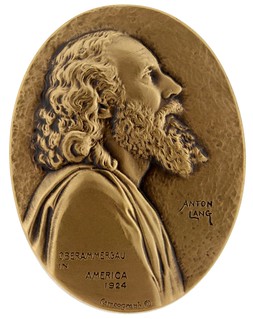
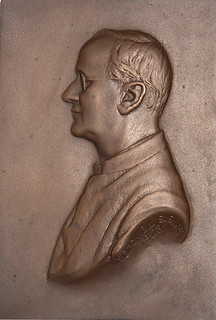
The lower right name on the oval medal (left) one might think would be the signature of the artist. It is not, it is the name of the actor shown on the medal in the role of Christ in the German passion play Oberammergan mentioned below. It is the only known medal made be the cameograph process in America. The New York studio had the 2-inch uniface medal struck by Medallic Art Company. The 4 5/8-inch medal on the right is one of several made in London for their studio established by the developer of the mechanical-photographic device. The Cameograph process was short lived because it could not equal that of live medallic artists.
Cameograph. Projecting an object with a grid or beams of light to reproduce it; often of a face to model a portrait in relief. The use of a Cameograph was thought by its developers to aid in making a portrait more lifelike. However, at its best it makes the subject appear more stiff or frozen, in effect accomplishing just the opposite. It falls short in perspective and animation by limiting the artist's ability to interpret and vivify his subject. The technique is called physiognotrace ("tracing the face").
SAMUEL BRECK (1771-1862)
E-Sylum Feature Writer and American Numismatic Biographies author Pete Smith submitted this article on early American numismatic author Samuel Breck. Thanks! -Editor
Joel J. Orosz contributes the Numismatic Bookie
column to Coin World. The June 16 issue
mentions an early numismatic writer, Samuel Breck. I think he is worthy of an article.
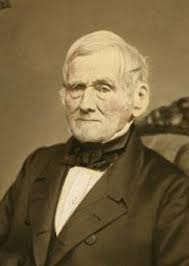 Samuel Breck was born in Boston on July 17, 1771. His father was Samuel Breck Sr. (1747-
1809) and mother was Hannah Andrews (1747-1830). The father was a prosperous Boston
merchant and one who made a profit during the Revolutionary War. He was a fiscal agent for the
Royal Army and Navy of France and after the war, a director of the Bank of the United States.
The family moved to Philadelphia in 1793.
Samuel Breck was born in Boston on July 17, 1771. His father was Samuel Breck Sr. (1747-
1809) and mother was Hannah Andrews (1747-1830). The father was a prosperous Boston
merchant and one who made a profit during the Revolutionary War. He was a fiscal agent for the
Royal Army and Navy of France and after the war, a director of the Bank of the United States.
The family moved to Philadelphia in 1793.
The Revolutionary War ended with the signing of the Treaty of Paris on September 3, 1783. At about that time, at age eleven, Samuel was sent to school in France. He attended the Royal Military School at Loreze, France, 1783 to 1787.
With $10,000 provided by his father in 1790, he established a shipping business as a merchant in Philadelphia.
THE FRIEDBERGS' DEPARTMENT STORE COIN SHOPS
Peter Tompa published a nice article on department store coin shops in Kate Fitz Gibbon's Cultural Property News, which covers national and international news affecting the art world, from in-depth research and reports on art and cultural policy to articles on museums, exhibits, the art market, media, education, technology, archeology, anthropology, and scientific discoveries.
We're publishing this excerpt with permission. You can subscribe to the free newsletter on the homepage at https://culturalpropertynews.org/ . -Editor
Art Friedberg grew up as part of perhaps the only family coin business operated out of major department stores. During college at George Washington University, he started working at his family's concession at Woodward and Lothrop in downtown Washington, DC. The operation sold a wide variety of US, foreign, and ancient coins as well as common ancient oil lamps and coins supplies not only at Woodies
in Washington, DC, but through franchises at other major department stores around the country.
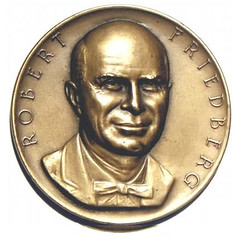 It all started with Art's dad, Robert. Robert's story is a bit unusual, but it broadly followed the trajectory of other self-starting American entrepreneurs of the early 20th century. Robert was born in Atlantic City, New Jersey, in 1912 to a family of Russian/Polish-Jewish immigrants. As a kid, he acquired his first foreign coins from sailors who visited his father's tailor shop located near the Harborside Terminal on the New Jersey side of the Hudson River. While at college in New York City, he founded Capitol Coin Company, a mail order coin business, with his 16-year old brother, Jack. During World War II, he served in the US Army in Europe, where he was able to acquire more inventory for his growing business.
It all started with Art's dad, Robert. Robert's story is a bit unusual, but it broadly followed the trajectory of other self-starting American entrepreneurs of the early 20th century. Robert was born in Atlantic City, New Jersey, in 1912 to a family of Russian/Polish-Jewish immigrants. As a kid, he acquired his first foreign coins from sailors who visited his father's tailor shop located near the Harborside Terminal on the New Jersey side of the Hudson River. While at college in New York City, he founded Capitol Coin Company, a mail order coin business, with his 16-year old brother, Jack. During World War II, he served in the US Army in Europe, where he was able to acquire more inventory for his growing business.
TREASURE TALK WITH BOB EVANS, EPISODE 6.1
In January, our good friend Bob Evans began publishing a series of blog articles on the Finest Known website detailing his experience as co-discoverer and curator of the treasures recovered from the wreck of the S.S. Central America. Subject of the book "Ship of Gold", many exhibits, countless interviews and articles, books and auction catalogs feature the legendary haul of gold coins, bars, nuggets, gold dust and more from the 1857 shipwreck. Here's another excerpt - see the complete article online. -Editor
It is almost laughable now, in the wake of our discovery, but before the SSCA treasure entered the market, the Professional Coin Grading Service (PCGS,) had graded only 315 mint-state Type I double eagles dated 1850 – 1857. Curating and submitting the SSCA treasure in 2000 – 2001 added 4,042 mint-state 1857-S, 255 mint-state 1856-S, 58 mint-state 1855-S, and 4 mint-state 1854-S to the mix.
When I showed numismatic expert Walter Breen examples of the treasure at Christie's in 1990 (see Treasure Talk 3: Part 2), he was thrilled to see such fresh
material, where so much detail could be easily seen. During the time we gave him for examination he began making notes about die varieties, differences between coins struck with specific sets of tools (dies.) He alerted me to the existence of such varieties, where tiny and even microscopic features reveal the individual characteristics of tools the Mint used to stamp plain gold disks (known as planchets) into coins. Breen showed me examples of the differences, easy to see with a loupe, particularly in the lettering seen in the legend, UNITED STATES OF AMERICA / TWENTY D.
There was a Broken A
in STATES
here, a missing serif on the U
in UNITED
there, as well as variations in the exact position of the mint mark S.
HOWARD GIBBS COIN ROBBERY ARREST
I've spoken in the past about my fellow Pittsburgh collector Howard D. Gibbs, who had an insatiable appetite for acquiring coins and often went to the ends of the earth like Indiana Jones to do so, particularly with his specialty of Odd and Curious (now known as Ethnographic) money.
This week I was contacted by a descendant of Gibbs who had seen a video of my talk on Gibbs. They shared a 1919 newspaper article about an incident I wasn't aware of, which "highlights the extent to which he would go to acquire coins." They didn't mind my sharing it here. -Editor
NUMISMAGRAM MEDAL SELECTIONS: JULY 6, 2025
Numismagram's Jeremy Bostwick sent along these five medals from his most recent upload of new material to his site. For all of the new items, please visit https://www.numismagram.com/inventory. -Garrett
103241 | GREAT BRITAIN. Foundation of the City of London School bronze Medal. Issued 1837. City of London series (57mm, 76.74 g, 12h). By Benjamin Wyon. CITY OF LONDON SCHOOL, façade of the school; in three lines in exergue, FOUNDED / BY THE CORPORATION / 1834 // FOR THE RELIGIOUS & VIRTUOUS EDUCATION OF BOYS & THEIR INSTRUCTION IN LITERATURE & USEFUL KNOWLEDGE, female allegory of Knowledge seated right, resting elbow upon Bible and instructing Youth standing to right, holding book and resting elbow upon plinth surmounted by civic coat-of-arms of London and inscribed IOHN / CARPENTER / 1447 in three lines; basket of scrolls to left, globe to right. Edge: Plain. BHM 1680; Eimer 1279; Taylor 120a; Eidlitz 159; Welch 4. Gem Mint State. Glossy red-brown surfaces, with great depth imparted unto the building façade. Though not as scarce as many of the other medals in the City of London series, this is an unusually superb, problem free representative of the type. Ex: Presidential Coin & Antique 83 (22 June 2013), lot 342. $295.
Authorized by the Royal Entertainments Committee, the Corporation of the City of London published numerous medals from 1831 to 1893 to commemorate important events in the life of the city, with this type serving as the fourth in the series. These medals specifically were used as School prizes across various subjects throughout the second half of the 19th century.
To read the complete item description, see:
103241 | GREAT BRITAIN. Foundation of the City of London School bronze Medal.
(https://www.numismagram.com/product-page/103241)
ST. JAMES'S AUCTIONS JULY 2025 SALE
Here's the press release for the upcoming Auction 108 from St. James's Auctions. -Editor
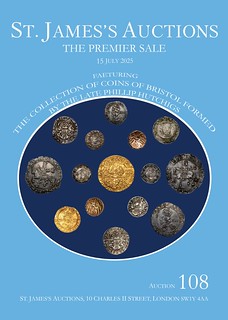 St. James's Auctions is pleased to present the upcoming premier auction scheduled
for 15 July starting at 11 am BST.
St. James's Auctions is pleased to present the upcoming premier auction scheduled
for 15 July starting at 11 am BST.
The auction consists of a good selection of rare and desirable coins including three different collections, alongside a range of other properties.
The sale commences with the fantastic Philip Hutchings Collection of Coins of Bristol, which spans from the Celtic period through to coins of Charles I. Phil was an active member of the numismatic community, who is much missed. He dearly loved Bristol and the history of the area, which he applied to his coin collection (lots 1001-1122).
THE BOOK BAZARRE
COMPLETE SET OF UMAYYAD GOLD DINARS
Morton & Eden are offering a rare complete set of 56 Umayyad gold dinars in their upcoming sale. -Editor
Morton & Eden Ltd, London-based specialist coin and medal auctioneers, will be offering for sale a complete set of 56 Umayyad gold dinars dating from years 77 to 132 Hijra (CE 696-750).
It comprises one coin of each date, all in excellent condition including the very rare year 77 dinar. They are expected to realise £200,000-300,000 in an auction sale in London on 23 July.
Such sets are rarely encountered and are of great importance to Muslims as they represent the very first purely Islamic gold coinage.
Tom Eden, Director of Morton & Eden, commented, Morton & Eden sold the majority of the
coins in this assembled set in 2006 and we are delighted to be handling the sale again almost
two decades later. The very rare year 77 dinar is especially significant as it was issued by the
great caliph ‘Abd al-Malik bin Marwan who reformed the coinage in this year and set the pattern
for Islamic coins for centuries to follow.
DAVISSONS E-AUCTION 51
Davissons E-Auction 51, closing Wednesday, July 23rd 2025, is online now. Here is their press release. -Garrett
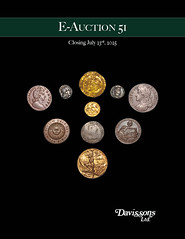 E-Auction 51 is a compact sale of just over 300 lots covering a wide range of coins and related pieces, representing the US and around the world, and eras from ancient to modern.
E-Auction 51 is a compact sale of just over 300 lots covering a wide range of coins and related pieces, representing the US and around the world, and eras from ancient to modern.
It begins with a bit of gold at a time when gold is popular far beyond numismatic interests, interesting and affordable Greek coinage including some appealing silver, bronze and a group of rare Peloponnesos issues (lots 37-43) that merit a look. Ancient Rome is represented by a diverse Provincial, Republican, and Imperial group, a few sestertii, some high grade later silver and, in a modest departure from these currency issues, a group of lead seals and some Paduans.
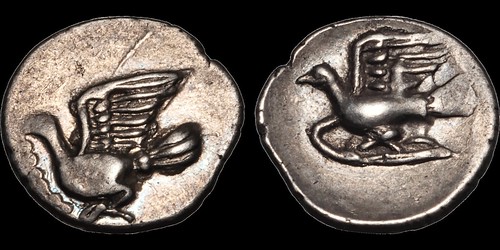
Lot 39. PELOPONNESOS. SIKYONIA. Sikyon. Circa 350-330/20 B.C. AR obol. .89 gm. 12 mm. Dove alighting left, holding fillet in beak / Dove flying left. BCD Peloponnesos 244. HGC 5, 224. Good Very Fine; beautiful lustrous tone with iridescence; struck on good metal.
NUMISMATIC NUGGETS: JULY 6, 2025
Here's a selection of interesting or unusual items I came across in the marketplace this week. Tell us what you think of some of these. -Editor
1854 Art Union of London Medal
Early Victorian 'Art Union of London' bronze medallion c1854 (wt: 82g)
A nice medallic portrait of William Wyon. I don't believe I've seen this medal before. -Editor
To read the complete lot description, see:
Lot 492: Early Victorian 'Art Union of London' bronze medallion c1854 (wt: 82g)
(https://www.invaluable.com/auction-lot/Early-Victorian-Art-Union-of-London-bronze-meda-492-c-61C454EA45)
Other topics this week include a Columbia Farthing, a Jewish Quarter Token and the 1927 George V Proof Crown. -Editor
SPANISH MUSEUM DISPLAYS 50,000 COIN HOARD
The National Archaeological Museum in Madrid recently announced that it will display a hoard of 50,000 Roman coins for the first time after their 2016 discovery. Thank you to Leon Saryan for sending it. -Garrett
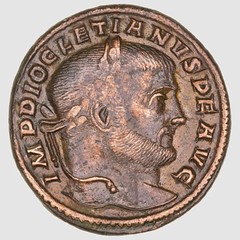 Spanish officials recently unveiled a trove of priceless Ancient Roman coins, marking the first time the massive collection has been put on public display.
Spanish officials recently unveiled a trove of priceless Ancient Roman coins, marking the first time the massive collection has been put on public display.
The National Archaeological Museum in Madrid recently announced the Treasure of Tomares
exhibit in a press release.
Discovered during a construction project in Tomares, Spain, in 2016, the collection consists of over 50,000 coins.
The coins date between the late third century and the early fourth century A.D.
Subsequent investigations revealed this location corresponded to an olive estate of ancient Hispalis, the Roman-era Seville.
The museum added, To reinforce the historical context, the exhibition is complemented by a selection of this type of coin, bronze pieces with a silver surface coating belonging to the nine emperors who succeeded during this period, in addition to seven specimens considered unique due to the exceptional iconography of their reverses.
EXPLORING THE COINS OF CHARLEMAGNE
Mike Markowitz wrote an article in CoinWeek on the coins of Charlemagne. Here's an excerpt - see the complete article online. -Garrett
The Roman system of coinage outlived the Roman Empire itself. Prices were still being quoted in silver denarii in the time of Charlemagne, king of the Franks, from 768 to 814. The difficulty was that by the time Charlemagne was crowned Imperator Augustus in 800, there was a chronic shortage of silver in Western Europe.… So rare was the denarius in Charlemagne's time that twenty-four of them sufficed to buy a Carolingian cow. (Ferguson, 2008. page 24)
We don't know where he was born – possibly somewhere in what is now Belgium. The year is uncertain – some sources indicate 742, while others suggest 747 or 748. Ironically, his name in the English-speaking world is Charlemagne, a French version of Charles the Great,
although his mother tongue was Old High German, and he would have referred to himself as Karlus (or Carlus). This name appears on many of his coins. His father, Pepin the Short,
was king of the Franks (ruled 751-768). His grandfather was Charles Martel (c. 688-741), the legendary warlord who defeated the Muslim invasion of Gaul at the Battle of Tours (October 10, 732). He fathered at least twenty children by numerous women; some historians regard Charlemagne as the Father of Europe.
The extensive coinage in his name set the pattern for Western European currency for centuries to come.
The Coins of Charlemagne Tell a Story
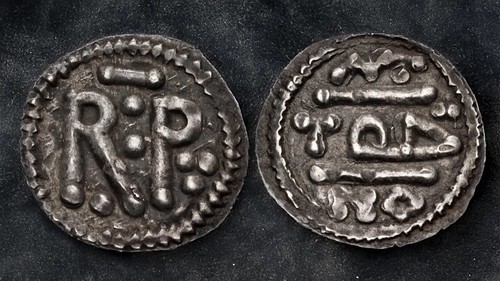
Pépin the Short. 754/5-768. Silver Denier (18mm, 1.10 g) Uncertain mint, possibly St. Denis. Depeyrot 892/2. Image: CNG / CoinWeek.
When Karl's father, Pepin the Short,
came to the throne in 751, the currency of the Frankish kingdom was a mess. Under the do-nothing
kings of the previous Merovingian dynasty, hundreds of local mints – often just a village blacksmith or goldsmith's shop – turned out a bewildering variety of crudely struck pieces in small batches without any standardization of weight, silver alloy fineness, or design. Most coins were deniers (from the Latin denarius), nominally weighing about 1.3 grams, although many were severely underweight. There was also a small obole, valued at half a denier. In 755, Pepin initiated a major coinage reform, bringing all minting under royal control. Pepin's new denier bore bold letters R:P on the obverse, abbreviating the Latin Rex Pipinus (King Pepin.
) Reverses bore a few garbled letters, possibly an abbreviated name of the mint; many of these have never been deciphered.
2026 SEMIQUINCENTENNIAL COINAGE
Jeff Garrett published an NGC article on special coin and medal issues for the U.S. semiquincentennial. Here's an excerpt - see the complete article online. -Editor
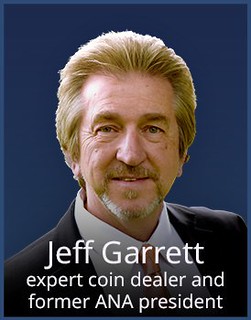 Starting later this year, you will probably start hearing the tongue-twisting term "Semiquincentennial" quite often. The term represents the celebration of the 250th anniversary of the signing of the Declaration of Independence. This landmark anniversary for the United States will be widely heralded around the world.
Starting later this year, you will probably start hearing the tongue-twisting term "Semiquincentennial" quite often. The term represents the celebration of the 250th anniversary of the signing of the Declaration of Independence. This landmark anniversary for the United States will be widely heralded around the world.
The year 2026 also promises to be a landmark year for numismatics, as well. The US Mint will be issuing an array of special commemorative coins to mark the occasion. One of the most interesting numismatic issues that has been announced is the first-ever "bell-shaped" coin, which is based on the Liberty Bell in Philadelphia. This innovative mint product is sure to be popular with collectors seeking an interesting relic of the celebration.
The US Mint will also be issuing special "privy mark" coins noting the dates 1776-2026 on several circulating coins. The public will be encouraged to search their pocket change for these special issues. More details on these and other 2026 US Mint coins will become available as the year progresses.
HYDERABAD HOTEL TOKENS
In Hyderabad, India, tokens were used in hotel kitchens, issued in different shapes or with different letters stamped on them to signal what food to cook and serve. The system still survives in some hotels to this day. -Garrett
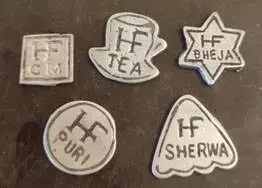 In the busy hotels of Hyderabad's old city, where the aroma of Irani chai, malai bun, and paya soup filled the air long before the arrival of QR codes, a small metal token was used to manage orders — a system that still survives in a few hotels. It was not a currency coin but a simple handmade token that helped kitchens run smoothly. This system was introduced many years ago, especially in the old city. Customers would go to the counter, pay for their food, and receive a small token instead of a printed bill.
In the busy hotels of Hyderabad's old city, where the aroma of Irani chai, malai bun, and paya soup filled the air long before the arrival of QR codes, a small metal token was used to manage orders — a system that still survives in a few hotels. It was not a currency coin but a simple handmade token that helped kitchens run smoothly. This system was introduced many years ago, especially in the old city. Customers would go to the counter, pay for their food, and receive a small token instead of a printed bill.
In the busy hotels of Hyderabad's old city, where the aroma of Irani chai, malai bun, and paya soup filled the air long before the arrival of QR codes, a small metal token was used to manage orders — a system that still survives in a few hotels.
It was not a currency coin but a simple handmade token that helped kitchens run smoothly. This system was introduced many years ago, especially in the old city. Customers would go to the counter, pay for their food, and receive a small token instead of a printed bill.
Each token, shaped differently to represent a specific dish, was handed over to the waiter by the customer or given by the cashier — signalling to the kitchen what to cook and serve.
THE SAIFABAD MINT MUSEUM
Coincidentally, this week I also ran across an article about a numismatic museum in Hyderabad - the Saifabad Mint Museum. -Editor
Tucked away in the heart of Hyderabad is a lesser-known yet fascinating treasure, the Saifabad Mint Museum. A place where history meets heritage, and metal tells stories, this museum is a must-visit for history lovers, coin collectors, and curious minds alike. Not just another museum, Saifabad Mint is a walk through India's rich numismatic journey the story of coins, currency, and craftsmanship.
1849 $20 CENTRAL AMERICA COMMEMORATIVE
Last week we mentioned the 1857 $10 Vaquero Reproduction created by Ron Landis from gold recovered from the SS Central America shipwreck. Now's a good time to mention another Landis work, the 1849 Type I Double Eagle commemorative also struck from SS Central America gold. They're offered by Adam Crum's Finest Known. Here's their website product description. -Editor
Introducing the 1849 Type I Double Eagle SS Central America Commemorative Restrike
The discovery of gold at Sutter's Mill in 1848 ignited the California Gold Rush, one of the most transformative events in American history. As thousands of fortune seekers flooded into the West, vast quantities of gold were unearthed, forever altering the national economy. The influx of raw gold created a critical need for a higher denomination coin to facilitate large transactions and absorb the growing supply of bullion entering the U.S. Mint.
EAST CARIBBEAN STATES CURRENCY
Stack's Bowers Currency Auction Associate Joe Pyle published this article about the East Caribbean States and their currency in the firm's Paper Money of the Week column. -Garrett
While working on our Summer 2025 Global Showcase Auction, a collection of East Caribbean States $100 banknotes came across my desk. Their attractive design caught my eye, so I decided to do some research and was surprised at the number of varieties available for these notes. Here I will look closely at some of these notes and their history, focusing on the $100 denomination. This blog is based on an earlier article written by my colleague Dennis Hengeveld that is no longer available online.
Starting in the early 17th century, the British claimed several islands in the Caribbean, competing directly with Dutch, French, and Spanish interests in the region. Early claims included St. Kitts (the first British settlement in the region — 1624), Antigua, and Montserrat (both 1632). British control spanned a large area, with territories in both the Leeward and Windward islands of the Caribbean, collectively known as the British West Indies. Most of the islands were combined into the short-lived West Indies Federation in 1962 after initially being divided into Windward and Leeward islands. Following the dissolution, some nations gained independence while others became colonies under London authority.
LOOSE CHANGE: JULY 6, 2025
Here are some additional items in the media this week that may be of interest. -Editor
We don't generally discuss grading and prices, but we do cover hobby history and this new Red Book Podcast with guest John Albanese of CAC Grading provides a great overview of the evolution of coin collecting and grading, market dynamics and more. -Editor
The conversation with John Feigenbaum and Jeff Garrett covers topics such as potential expansion into world coins, the role of AI in grading, and the popularity of different type coins. The trio also discuss industry trends, including "gradeflation," the impact of economic uncertainties on the market, and recent business developments in the hobby.
To watch the complete interview, see:
Red Book Podcast with Special Guest: John Albanese of CAC Grading
(https://www.greysheet.com/news/story/red-book-podcast-with-special-guest-john-albanese-of-cac-grading)
John Albanese on CAC, Grading Services, Gradeflation, Moderns vs. Classic Coins, Market Trends...
(https://www.youtube.com/watch?v=W_YalShM1Os)
Other topics this week include the history of currency in the U.S., and the 1983 Great Britain Newpence Mule Error. -Editor
FEATURED WEBSITE: HISTORICAL MEDAL SOCIETY
This week's Featured Website is the Historical Medal Society.
The Historical Medal Society was established in 2014 by two British numismatists keen to promote the study of historical medals and medallions. The Society meets annually at Medallion Congress and publishes research in the Historical Medal Journal.
The most recent edition of the Historical Medal Journal, Number 6, was published in June 2024 and is available for purchase.
The 11th Medallion Congress will be held at the The Stratford Manor Hotel, Warwick on 12 July 2025.
The Society welcomes requests to help identify medals or medallions, so if you have a mystery medal and think we may be able to help, please contact us (attaching an image if possible).
https://www.historicalmedalsociety.org.uk/
ABOUT THIS ISSUE: JULY 6, 2025
Pretty normal week for The E-Sylum. On Wednesday I sent Garrett several articles to work on and when he finished them on Saturday I added them to the issue. The Friday holiday let me get caught up on quarterly bookkeeping chores with our advertisers and sponsors.
Favorite non-numismatic article headline of the week: 7 Body Parts That Are More or Less Useless . But I like my Palmaris Longus... -Editor

